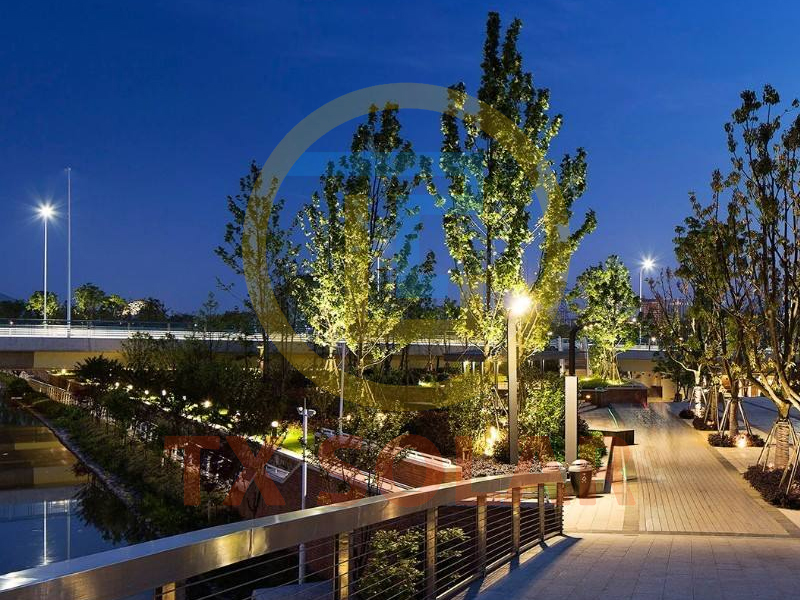Garden lights play a vital role in enhancing the aesthetics and functionality of outdoor spaces, especially in parks. Proper park lighting can not only illuminate pathways and recreational areas, but also create a welcoming atmosphere for visitors. Choosing the right garden lights for park lighting can be a daunting task given the variety of options available. This article will guide you through the basic factors to consider when choosing garden lights for park lighting.
1. Understand the purpose of lighting
Before delving into the selection process, it is necessary to understand the main purpose of lighting. In parks, garden lights serve multiple functions:
- Safety: Well-lit roads and areas reduce the risk of accidents and deter criminal activity.
- Aesthetics: Beautifully designed lights can enhance the visual appeal of your park, making it more attractive.
- Function: Different areas of the park may require different types of lighting, such as brighter lights for sports fields and softer lights for picnic areas.
2. Assessment area
The next step is to evaluate the layout of the park and the specific areas that need lighting. Consider the following points:
- Paths: Identify main walking paths and ensure they are well lit to guide visitors safely.
- Recreational Areas: Sports fields, playgrounds and picnic spots may require brighter lights to make them visible at night.
- Natural Features: If your park has beautiful trees, ponds, or sculptures, consider using garden lights to highlight these features.
3. Choose the appropriate type of garden light
There are many types of garden lights suitable for park lighting. Here are some popular options:
- Path Lights: These lights are usually lower to the ground and are great for lighting up walkways. They come in a variety of styles, from modern to traditional, allowing you to match the aesthetic of your park.
- Spotlights: Spotlights are great for highlighting specific features like trees or sculptures, creating a dramatic effect and drawing attention to unique elements of your park.
- Floodlights: They provide a wide range of lighting and are ideal for larger areas such as sports fields or open spaces. They can be pole mounted for maximum coverage.
- String Lights: For a whimsical feel, hang string lights on a tree or along a path to create a cozy atmosphere for nighttime gatherings.
4. Consider energy efficiency
In today’s environmentally conscious world, energy efficiency is an important factor when choosing garden lights for park lighting. LED lights are an excellent choice because they use less energy and last longer than traditional incandescent bulbs. Also consider solar lights, which harness sunlight during the day and illuminate the park at night without increasing electricity costs.
5. Evaluate durability and weather resistance
Parks face a variety of weather conditions, so choosing garden lights that are durable and weather-resistant is crucial. Look for lights made from materials like stainless steel, aluminum, or high-quality plastic that can withstand rain, snow, and UV rays. Check the IP (Ingress Protection) rating of the light; a higher rating indicates better protection against dust and moisture.
6. Maintenance plan
Maintenance is an important aspect of park lighting. Choose garden lights that are easy to maintain and replace. Consider the following points:
- Accessibility: Make sure the lamp is installed in a location where maintenance and bulb replacement are easy.
- Long life: Choose lamps with long service life to reduce replacement frequency.
- Clean: Choose a design that is easy to clean, as dirt and debris can accumulate and reduce the lamp’s effectiveness.
7. Create a lighting design plan
Once you’ve assessed the area and selected the type of lighting, it’s time to create a lighting design plan. The plan should include:
- Light Placement: Determine where each type of light should be installed for optimal illumination.
- Spacing: Make sure lights are properly spaced to avoid black spots and prevent certain areas from being too bright.
- Control Systems: Consider installing timers or motion sensors to control when lights turn on and off to increase energy efficiency.
8. Comply with local regulations
Before making your final choice of garden lights, check your local regulations regarding outdoor lighting. Some areas may have restrictions on light pollution, brightness levels, or specific types of fixtures. Ensuring compliance not only keeps you within the law but helps create a more harmonious environment.
In conclusion
Choosing the right garden lights for park lighting is a multifaceted process that requires careful consideration of various factors. By understanding the purpose of lighting, evaluating the area, selecting appropriate light types, and planning maintenance, you can create a beautifully lit park that enhances safety, beauty, and functionality. With the right approach, your park can become a vibrant community space that invites visitors to enjoy the outdoors, even after the sun goes down.
Post time: Sep-26-2024

